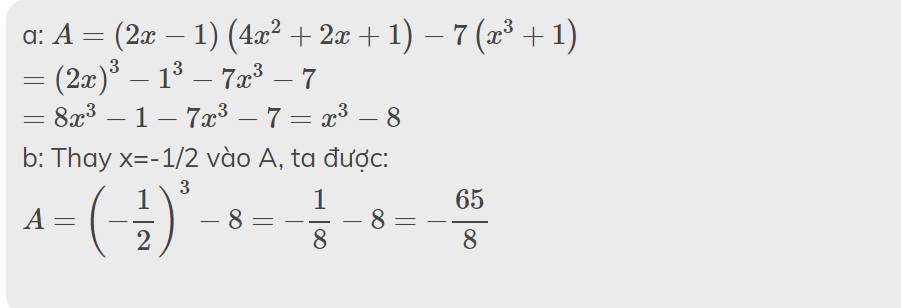a,Tìm các giá trị nguyên của x để phân thức A có giá trị nguyên:
A=x3−4x2+4x−10x−3
Hãy nhập câu hỏi của bạn vào đây, nếu là tài khoản VIP, bạn sẽ được ưu tiên trả lời.

a: \(A=\left(2x-1\right)\left(4x^2+2x+1\right)-7\left(x^3+1\right)\)
\(=\left(2x\right)^3-1^3-7x^3-7\)
\(=8x^3-1-7x^3-7=x^3-8\)
b: Thay x=-1/2 vào A, ta được:
\(A=\left(-\dfrac{1}{2}\right)^3-8=-\dfrac{1}{8}-8=-\dfrac{65}{8}\)


c: \(A=x^3-8=\left(x-2\right)\left(x^2+2x+4\right)\)
Để A là số nguyên tố thì x-2=1
=>x=3

Bài 1:
a) x≠2x≠2
Bài 2:
a) x≠0;x≠5x≠0;x≠5
b) x2−10x+25x2−5x=(x−5)2x(x−5)=x−5xx2−10x+25x2−5x=(x−5)2x(x−5)=x−5x
c) Để phân thức có giá trị nguyên thì x−5xx−5x phải có giá trị nguyên.
=> x=−5x=−5
Bài 3:
a) (x+12x−2+3x2−1−x+32x+2)⋅(4x2−45)(x+12x−2+3x2−1−x+32x+2)⋅(4x2−45)
=(x+12(x−1)+3(x−1)(x+1)−x+32(x+1))⋅2(2x2−2)5=(x+12(x−1)+3(x−1)(x+1)−x+32(x+1))⋅2(2x2−2)5
=(x+1)2+6−(x−1)(x+3)2(x−1)(x+1)⋅2⋅2(x2−1)5=(x+1)2+6−(x−1)(x+3)2(x−1)(x+1)⋅2⋅2(x2−1)5
=(x+1)2+6−(x2+3x−x−3)(x−1)(x+1)⋅2(x−1)(x+1)5=(x+1)2+6−(x2+3x−x−3)(x−1)(x+1)⋅2(x−1)(x+1)5
=[(x+1)2+6−(x2+2x−3)]⋅25=[(x+1)2+6−(x2+2x−3)]⋅25
=[(x+1)2+6−x2−2x+3]⋅25=[(x+1)2+6−x2−2x+3]⋅25
=[(x+1)2+9−x2−2x]⋅25=[(x+1)2+9−x2−2x]⋅25
=2(x+1)25+185−25x2−45x=2(x+1)25+185−25x2−45x
=2(x2+2x+1)5+185−25x2−45x=2(x2+2x+1)5+185−25x2−45x
=2x2+4x+25+185−25x2−45x=2x2+4x+25+185−25x2−45x
=2x2+4x+2+185−25x2−45x=2x2+4x+2+185−25x2−45x
=2x2+4x+205−25x2−45x=2x2+4x+205−25x2−45x
c) tự làm, đkxđ: x≠1;x≠−1

\(A=\frac{x^3-4x^2+4x-10}{x-3}\)( ĐKXĐ : x ≠ 3 )
\(=\frac{x^3-3x^2-x^2+3x+x-3-7}{x-3}\)
\(=\frac{x^2\left(x-3\right)-x\left(x-3\right)+\left(x-3\right)-7}{x-3}\)
\(=\frac{\left(x-3\right)\left(x^2-x+1\right)-7}{x-3}\)
\(=\frac{\left(x-3\right)\left(x^2-x+1\right)}{x-3}-\frac{7}{x-3}\)
\(=\left(x^2-x+1\right)-\frac{7}{x-3}\)
Vì x ∈ Z nên ( x2 - x + 1 ) ∈ Z
nên để A ∈ Z thì \(\frac{7}{x-3}\)∈ Z
hay ( x - 3 ) ∈ Ư(7) = { ±1 ; ±7 }
| x-3 | 1 | -1 | 7 | -7 |
| x | 4 | 2 | 10 | -4 |
Các giá trị tm ĐKXĐ
Vậy x ∈ { ±4 ; 2 ; 10 } thì A ∈ Z
\(ĐKXĐ:x\ne3\)
\(A=\frac{x^3-4x^2+4x-10}{x-3}=\frac{x^3-3x^2-x^2+3x+x-3-7}{x-3}\)
\(=\frac{x^2\left(x-3\right)-x\left(x-3\right)+\left(x-3\right)-7}{x-3}\)
\(=\frac{\left(x-3\right)\left(x^2-x+1\right)-7}{x-3}=\left(x^2-x+1\right)-\frac{7}{x-3}\)
Vì \(x\inℤ\)\(\Rightarrow x^2-x+1\inℤ\)
\(\Rightarrow\)Để \(A\inℤ\)thì \(\frac{7}{x-3}\inℤ\)\(\Rightarrow7⋮x-3\)
\(\Rightarrow x-3\inƯ\left(7\right)=\left\{-7;-1;1;7\right\}\)
\(\Leftrightarrow x\in\left\{-4;2;4;10\right\}\)( thỏa mãn ĐKXĐ )
Vậy \(x\in\left\{-4;2;4;10\right\}\)

a) ĐKXĐ: \(x\notin\left\{1;-1\right\}\)
b) Ta có: \(\dfrac{4x-4}{2x^2-2}\)
\(=\dfrac{4\left(x-1\right)}{2\left(x-1\right)\left(x+1\right)}\)
\(=\dfrac{2}{x+1}\)
Để phân thức có giá trị bằng -2 thì \(\dfrac{2}{x+1}=-2\)
\(\Leftrightarrow x+1=-1\)
hay x=-2(thỏa ĐK)

a) Ta có: \(M=\dfrac{8x+1}{4x-5}=\dfrac{8x-10+11}{4x-5}=\dfrac{2\left(x-5\right)+11}{4x-5}=2+\dfrac{11}{4x-5}\)
Để M nhận giá trị nguyên thì \(2+\dfrac{11}{4x-5}\) nhận giá trị nguyên
\(\Rightarrow\dfrac{11}{4x-5}\) nhận giá trị nguyên
\(\Rightarrow11⋮4x-5\)
Vì \(x\in Z\) nên \(4x-5\in Z\)
\(\Rightarrow4x-5\inƯ\left(11\right)=\left\{\pm1;\pm11\right\}\)
\(\Rightarrow x\in\left\{1;\pm1,5;4\right\}\)
Vậy \(x\in\left\{1;4\right\}\) thỏa mãn \(x\in Z\).
b) Ta có: \(A=\dfrac{5}{4-x}\). ĐK: \(x\ne4\)
Nếu 4 - x < 0 thì x > 4 \(\Rightarrow A>0\)
4 - x > 0 thì x < 4 \(\Rightarrow A< 0\)
Để A đạt GTLN thì 4 - x là số nguyên dương nhỏ nhất
\(\Rightarrow4-x=1\Rightarrow x=3\)
\(\Rightarrow A=\dfrac{5}{4-3}=5\)
Vậy MaxA = 5 tại x = 3
c) \(B=\dfrac{8-x}{x-3}\). ĐK: \(x\ne3\).
Ta có: \(B=\dfrac{8-x}{x-3}=\dfrac{-\left(x-8\right)}{x-3}=\dfrac{-\left(x-3\right)+5}{x-3}=\dfrac{5}{x-3}-1\)
Để B đạt giá trị nhỏ nhất thì \(\dfrac{5}{x-3}-1\) nhỏ nhất
\(\Rightarrow\dfrac{5}{x-3}\) nhỏ nhất
Nếu x - 3 > 0 thì x > 3 \(\Rightarrow\dfrac{5}{x-3}>0\)
x - 3 < 0 thì x < 3 \(\Rightarrow\dfrac{5}{x-3}< 0\)
Để \(\dfrac{5}{x-3}\) nhỏ nhất thì x - 3 là số nguyên âm lớn nhất
\(\Rightarrow x-3=-1\Rightarrow x=2\)
\(\Rightarrow B=\dfrac{8-2}{2-3}=-6\)
Vậy MaxB = -6 tại x = 2.
Mình làm sai câu a...
Ta có: \(M=\dfrac{8x+1}{4x-1}=\dfrac{8x-2+3}{4x-1}=\dfrac{2\left(4x-1\right)+3}{4x-1}=2+\dfrac{3}{4x-1}\)
Để M nhận giá trị nguyên thì \(2+\dfrac{3}{4x-1}\) nhận giá trị nguyên
\(\Rightarrow\dfrac{3}{4x-1}\) nhận giá trị nguyên
Vì \(4x-1\in Z\) nên \(4x-1\inƯ\left(3\right)=\left\{\pm1;\pm3\right\}\)
\(\Rightarrow x\in\left\{\pm0,5;0;1\right\}\)
Vậy \(x\in\left\{0;1\right\}\) thỏa mãn \(x\in Z\).

`M=(10x^2-7x-5)/(2x-3)(x ne 3/2)`
`=(10x^2-15x+8x-12+7)/(2x-3)`
`=(5x(2x-3)+4(2x-3)+7)/(2x-3)`
`=5x+4+7/(2x-3)`
Để `M in ZZ`
`=>7/(2x-3) in ZZ`
`=>2x-3 in Ư(7)={+-1,+-7}`
`=>2x in {2,4,-4,10}`
`=>x in {1,2,-2,5}(tm)`
Vậy `x in {1,2,-2,5}` thì `M in ZZ`.